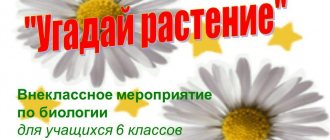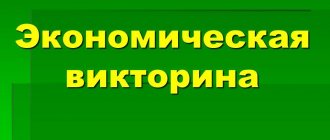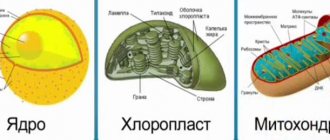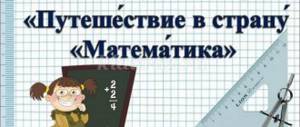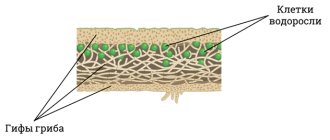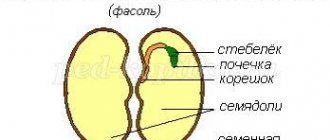Elective course in biology “Difficult issues in biology”
Topic 2. Cellular structures and their functions (2 hours)
Biological membranes. Structure and functions of the plasma membrane. Membrane organelles. Core. Vacuolar system of the cell. Mitochondria. Plastids. The musculoskeletal system of the cell. Ribosomes. Cellular inclusions. Demonstrations Diagrams and tables illustrating: the structure of the plasma membrane, the structure of animal and plant cells, prokaryotic and eukaryotic cells. Dynamic manual “Cell structure”.
Topic 3. Providing cells with energy (3 hours)
Metabolism and energy conversion in the cell. Concepts of metabolism, anabolism, catabolism. Sources of energy for living organisms. Autotrophs and heterotrophs. Fixation of sunlight energy by plants. Chlorophyll. The structure of the chloroplast. Photosynthesis. Light phase of photosynthesis. Photolysis of water. Dark phase of photosynthesis. Chemosynthesis. The role of chemosynthetic bacteria on Earth. Breakdown of polysaccharides - starch and glycogen. Anaerobic breakdown of glucose. Krebs cycle. Oxidative phosphorylation. The role of oxygen. Aerobes and anaerobes. Demonstrations Diagrams and tables illustrating: metabolism and energy conversion in the cell; chloroplast structure; photosynthesis process; structure of mitochondria; chemosynthesis process. Oxygen release by algae (in an aquarium) in the light.
Topic 4. Hereditary information and its implementation in the cell (6 hours)
Proteins are the basis of the specificity of cells and organisms. Genetic information. Matrix principle of protein synthesis. Transcription. Genetic code and its properties. Transfer RNAs. Protein biosynthesis. Regulation of transcription and translation. DNA doubling. Principles of replication. Features of eukaryotic DNA replication. Modern ideas about the structure of genes. Genome. The structure of chromosomes. Genetic Engineering. The structure of viruses. Reproduction of viruses. AIDS virus. Reverse transcription. Demonstrations Diagrams and tables illustrating: the replication process; genetic code; protein biosynthesis; regulation of transcription in prokaryotes; structure of the virus; chromosome structure. Dynamic model of protein synthesis on the ribosome.
Topic 5. Individual development and reproduction of organisms (5 hours)
Cell division of pro- and eukaryotes. Cell life cycle (interphase and mitosis). Phases of mitosis. Homologous and non-homologous chromosomes. Amitosis. Periods of ontogenesis. Development of the animal embryo. Cell differentiation. Embryogenesis of plants. Postembryonic development of animals and plants. Apoptosis. Multicellular organism as a single system. Stem cells. Regeneration. Interaction of cells in the body. Control of the integrity of the body. Immunity. Meiosis. Determination of sex in animals. Sexual and asexual reproduction. Somatic and germ cells. Alternation of haploid and diploid stages in the life cycle. Parthenogenesis. Formation of germ cells in animals and plants. Fertilization in animals and plants. Demonstrations Diagrams and tables illustrating: the structure of plant and animal tissues; methods of asexual reproduction; fertilization in plants and animals; stages of development of a vertebrate animal embryo; postembryonic development. Dynamic manuals “Cell division. Mitosis and meiosis", "Gametogenesis in animals".
